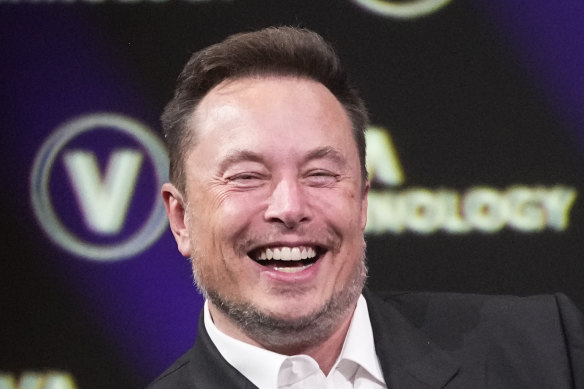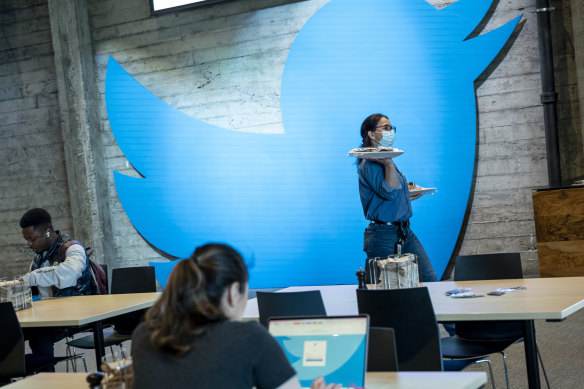This was published 1 year ago
Opinion
Elon Musk just doubled down on his deluded plan for world domination
Stephen Bartholomeusz
Senior business columnistIs the rebranding of Twitter the beginning of the end or the end of the beginning for Elon Musk’s dream of creating his “everything” app?
The decision to rebrand Twitter as “X” is either pragmatic, brave or foolhardy, given it entails throwing away the brand equity Twitter has established over the 17 years since its launch and jeopardising the value of the 350 million-plus users it still has.

Musk is an entrepreneur who has notched up some big successes, albeit one studded with regular setbacks and failures to meet his promised targets.Credit: AP
While Musk might have damaged the brand he paid $US44 billion for ($A68 billion at the time) by reintroducing previously suspended users to the platform, sacking three-quarters of the workforce, overseeing an unstable platform, losing more than half his advertisers and shedding users, it would still have value measured in the multiple billions.
The platform’s apparently hopeless financial predicament and weakened competitive position are perhaps the strongest arguments for radical change.
If Musk did nothing then Twitter’s finances would continue to deteriorate. Estimates that he overpaid when he bought Twitter by up to $US30 billion might, if he did nothing, end up looking wildly conservative.
Now he plans to try to create an American version of China’s WeChat, offering everything from multimedia, messaging, e-retail, search and financial and other services on a single app, competing head on with the likes of Amazon, Meta Platform’s suite of apps, Google, Microsoft, PayPal, traditional banks and neo banks, among others.
He doesn’t have the regulatory approvals, yet, to offer financial services, nor is the technology in place or the people he’s going to need to build it.
He’s also doing it off a very weak financial base, having not just trashed Twitter’s brands but its finances when he acquired the platform last year.
Twitter floats on a sea of debt, thanks to the $US13 billion of borrowings Musk took on to acquire it.
The reintroduction of hate speech, misinformation and disinformation to Twitter has cost him perhaps $US2.5 billion of revenue as advertisers fled, with Musk saying this month that revenue is tracking at about half that of last year.
The platform is generating negative cash flows, due to the combination of reduced revenue and the $US1.5 billion a year or so of interest costs associated with his acquisition debt.
It also now faces a direct competitor, with Facebook’s parent Meta launching its Twitter lookalike, “Threads,” which signed up more than 100 million users in less than a week after its launch.
On Sunday, newly hired chief executive Linda Yaccarino tweeted that “X is the future state of unlimited interactivity” – whatever that means – although she did say that it would include payments and the buying and selling of “goods, services and opportunities” powered by artificial intelligence. (Musk recently announced a new AI start-up called xAI).
Musk himself tweeted that, if done right, X “would become half the global financial system”. He’s deluded, but that does indicate the scale of his ambition, or perhaps of his delusion.
A major question mark (but not the only one) over the new strategy for the platform formerly known as Twitter is whether anyone actually wants a new “super app”.
For the concept to work, Musk would need to break into an already densely populated payments and financial services sector and convince a vast number of people that conducting all their activity via his app is better than accessing the same services from a range of established providers.
Can he out-Amazon, Amazon? Or do a better job on search than Google, or provide better banking than JPMorgan Chase or Bank of America or out-compete Meta’s cluster of social media and multimedia brands? How much would it cost to create those services, effectively from scratch?
He probably has the wealth to fund the attempt, although most of it is tied up in Tesla (whose shareholders will be less than enthusiastic that Musk’s already divided attention and potentially more of the wealth he has stored in Tesla shares will be even more devoted to “X” and his new AI vehicle).

Last year, Musk repeatedly warned employees at the social network that Twitter was at risk of bankruptcy, which he said necessitated sweeping job cuts.Credit: Bloomberg
Any normal corporate planning a rebranding exercise would have spent a lot of time and money considering the costs and benefits of changing an established brand and researching the response to the proposed new branding. Musk asked Twitter users to come up with designs and vote on the colour of the new logo and within a couple of days had chosen the stylised black “X”.
Such a massive and diverse expansion of services would normally mean months, or more likely years, designing the new product offerings, hiring the workforce and building the tech before announcing the launch of offers that can’t yet be delivered.
Indeed, any normal corporate would have stabilised the existing platform, locked in its unsettled user base and at least started to regain advertisers before contemplating a massive expansion and diversification.
That would, of course, mean undoing most of the changes Musk has made to the platform and re-hiring a lot of staff to ensure it functions as it should and that its content doesn’t deter users and advertisers.
Musk is an entrepreneur who has notched up some big successes, albeit one studded with regular setbacks and failures to meet his promised targets. He shouldn’t be underestimated but the half-baked way the rebranding and launch of “X” has been managed is the kind of eccentric, erratic and impulsive behaviour that got him entangled in the disaster that he’s made of Twitter in the first place.
The Business Briefing newsletter delivers major stories, exclusive coverage and expert opinion. Sign up to get it every weekday morning.